Re-posted courtesy of Thunderbolts.info.

El Pinacate y Gran Desierto de Altar is a geologic wonderland for volcanologists. It should also be a laboratory for study of the Electric Earth.
Pinacate is a monogenic volcanic field in Sonora, Mexico that lies just south of the Arizona border, seventy miles east of where the Colorado River empties into the Sea of Cortez. It is a protected Biosphere Reserve and World Heritage site.
Monogenic volcanic fields, meaning each eruptive feature in the field is the product of a single, short eruption of unique magma, are not uncommon in North America. In fact, Pinacate is one of fifty that dot the landscape from central Mexico to Colorado. What makes Pinacate special is its pristine nature, for it is largely untouched by human hands, or the effects of severe erosion.
 It’s location in the desiccated Altar Desert of Sonora is the reason it has remained pristine. As Edward Abbey wrote of the Altar: “This region is the bleakest, flattest, hottest, grittiest, grimmest, dreariest, ugliest, most useless, most senseless desert of them all. It is the villain among badlands, most wasted of wastelands, most foreboding of forbidden realms.” In other words, it was one of Abbey’s favorite places.
It’s location in the desiccated Altar Desert of Sonora is the reason it has remained pristine. As Edward Abbey wrote of the Altar: “This region is the bleakest, flattest, hottest, grittiest, grimmest, dreariest, ugliest, most useless, most senseless desert of them all. It is the villain among badlands, most wasted of wastelands, most foreboding of forbidden realms.” In other words, it was one of Abbey’s favorite places.
Geologists insist Pinacate is dormant, but recently so. It’s last eruption is dated a mere ten thousand years ago. But local lore of the Tohono O’odham people, descendants of the ancient Pueblo culture known as Hohokam, insist there have been two minor eruptions in the last century, one in 1928, and again in 1934. Seismographic records don’t bear this out, say geologists, indicating no seismic event associated with volcanic activity was recorded at the time.
 Its many lava flows and tephra beds portray the Pinacate as the result of three volcanic periods. First it developed as a shield volcano, raising the mountain that gives the field its name.
Its many lava flows and tephra beds portray the Pinacate as the result of three volcanic periods. First it developed as a shield volcano, raising the mountain that gives the field its name.
Pinacate is derived from the Aztec word for black beetle, and is commonly used for the desert stink bug. Identity with the mountain is understandable since stink bugs hold their rear high and emit a foul odor.
The next period brought blooms of pyroclastic eruption that left over five-hundred volcanic vents and cinder cones across 770-square-miles.
Its final phase created several maar craters. The Pinacate is best known for maars and the rings of tuff they create. There are about a dozen maars and tuff rings in the Pinacate.
The crown jewel is El Elegante. One mile in diameter, with steep sides sloping to a depth of 800 feet, it looks like a giant bottle cap was pressed into the earth to leave this depression. Its size, symmetry and scalloped edges earn ‘The Elegant One’ its name.

Maars are one expression of a diatreme volcano. Their creation is brief and explosive. Magma rises beneath moisture held in an aquifer, sub-surface stream, or permafrost, and vaporizes the water in a series of blasts that last from a few hours to several weeks. A shallow crater with a bowl floor and a low raised rim is left, over a rock-filled fracture called a diatreme. Typically, maars fill with water following eruption, leaving a lake. The maars of Pinacate are dry and accessible.

No certainty as to formation is truly known in consensus science. The inverted cone shape of a maar diatreme has been generally assumed to form by shallow explosions first, followed by progressively deeper explosions.
The explosions are thought to be caused by the instant vaporization of ground water when it contacts hot magma. If deep explosions occurred first, they would hollow out a wide void, not a conical vent.
But the shallow-first theory should produce ejecta of shallow rock covered by later deposits of deeper rock. Examination of maars show that deep rock fragments are well mixed with shallow rock, implying explosions occurred throughout all depths at once.
Geologist Greg Valentine, a professor at the University at Buffalo in New York, and James White, an associate professor at the University of Otago in New Zealand, have created a new model to account for the jumbled order of explosions. Their model, published online Sept. 18 by the journal Geology, suggests individual explosions are relatively small, and shallow explosions are more likely to cause eruptions than deep explosions.
The model did not include subsurface electrical discharge as a possible causation. Perhaps it should.
If it walks like a duck…
The likeness of Pinacate’s craters to Lunar craters made it a perfect training ground for Apollo astronauts. It’s also a reason the area should be of interest to the study of Electric Earth phenomena. Close inspection of craters and other features in Pinacate reveals more than a casual resemblance to the craters of the Moon. Let’s take a look.
Rim Craters…
Beginning with El Elegante, the Google Earth image below shows a rim crater at the four-o’clock position – the only flaw in its beautiful symmetry.


It is explained as an older cinder cone that was split in half by the maar eruption.
Rim craters also occur on other maars in the Pinacate. In fact, more than half of the maars have features that appear to be rim craters. Perhaps it is normal for maars to occur at the edge of older volcanic vents – perhaps the older vent plays a role in creating the maar. Or they may be what they look like, a feature caused by a filament of electrical discharge.
Rim craters occur with such regularity on rocky bodies in our solar system it is statistically absurd to think they are caused by chance impacts. They are a known feature of electrical discharge, as filaments of spark will form craters within craters, and often ‘stick’ to the rim of a crater previously formed, leaving rim craters.
The maar shown below is 0.9 miles wide and 250 feet deep. It also displays scalloped edges and a large rim crater at the five-o’clock position. Another small rim crater is at the nine-o’clock position (all overhead images are oriented with North up, at the 12-o’clock position).
Most confusing, assuming the consensus science view of how maars are created, is the small tuff rings in the floor of the crater beneath the large rim crater. In this case the rim features can’t be the remnant of an older cider cone since they could not possibly have pre-existed the maar eruption. It must be the remnant of events that followed the sequence of eruptions that made the maar – but where is the debris from this later event?


This maar, 2400 feet in diameter by 50 feet deep, at half past six-o’clock, has three apparent rim craters blanketed by an inflow of red ash, as if the event flattened the cinder cone next to it by pulling it in.


The next images show a rim crater at six-o’clock in a primary crater that is 2,600 feet in diameter by 150 feet deep. The triangular wedge is actually a slice from a pie-shaped depression at the rim.

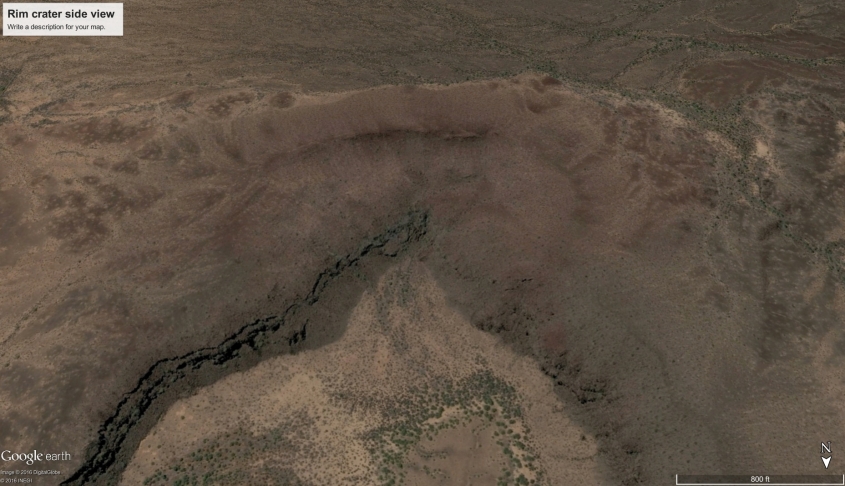
The next images are of a maar 3400 feet in diameter by six hundred feet deep. It shows a rim crater at eleven-o’clock. Grey ‘ejecta’ blankets the rim crater. But the side view shows the rim crater has a steep, conic depression below the grey material.
The grey ejecta is obviously associated with the maar and blankets the slopes and lava flow of the red cinder cones nearby. This appears to be the case with the other maars, indicating they occurred in the latest series of eruptive events. However, the question should be asked whether the material was blown-out, or sucked-in by the event that made the crater.


The grey blanket is formed into dunes (see top center of photo above). Dunes exhibit a gentle slope to windward, and a steep reverse slope to leeward, suggesting at least the final winds of this dramatic event were directed inward to the crater.
Cerro Colorado…
The best example of a rim crater in the Pinacate is Cerro Colorado. Thought to be the result of multiple blasts though several vents, the main crater is 3,200 feet across, with a canted rim. The lopsided rim is thought to have been created by prevailing wind depositing ejected material preferentially to the south, or because subsequent explosions caused the north side of the rim to collapse, depending on which consensus theory is chosen. Neither provides a satisfactory explanation of the rim’s appearance.


On closer look, it could also be interpreted that material was drawn in, the way a tornado draws ground winds to it, to create the lopsided rim. The neat, even edges and compact symmetry of the aureole around the rim appears to be caused by in-flowing winds rather than several explosive outward blasts.

In the next image, along the crater rim can be seen layers of deposition, consistent with the effects of winds being drawn inward to the crater.

The Electric Volcano…
There is no question that Pinacate is a volcanic field. The lava flows, ash and tuff attest to that. We see active volcanoes around the world. The Ukinrek eruptions on the Alaska Peninsula in 1977 created two maar craters.
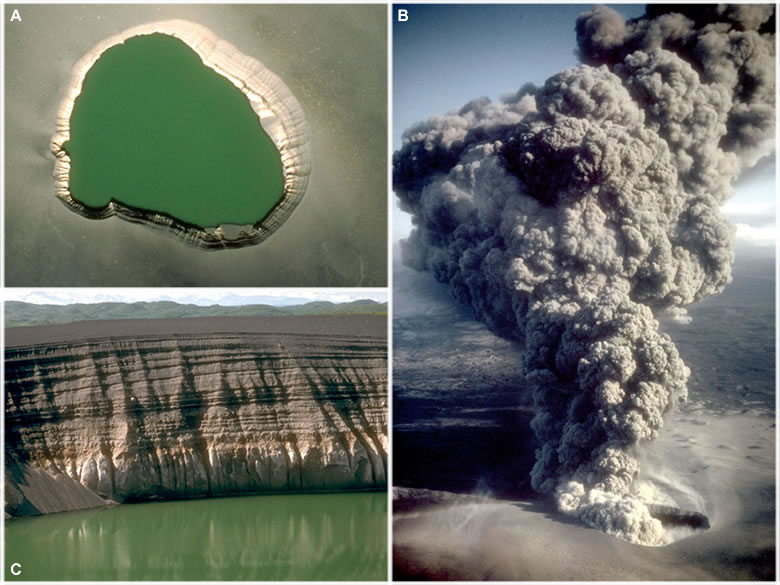
The largest of these maars, now filled with water to form a lake, erupted for ten days to create a crater 1,000 foot wide. The Photos above show the eruption and resulting maar.
The largest Pinacate maars are one mile in diameter. The largest known maar on Earth is on Alaska’s Seward peninsula, and is five miles wide. The magnitude of the Pinacate and Seward Peninsula events dwarf the Ukinrek, or any other eruptions seen in historical times.
Consensus science does not explore the electrical nature of volcanoes, and the potential effects of an intensified electric field. They should be interpreted with electromagnetic effects in mind to understand them fully.
If lightning can occur in the sky, why not in the ground?
A capacitor stores electrical charge up to a point, and then lets go, like a dam breaking. It’s called dielectric breakdown, and sparks are the result; sparks are the flood of current through the dam. Lightning is one example of a spark we’ve all seen, but there are several types of electric discharge to consider.
Each type represents a flow of current, electrons and/or ions in an electric field. What primarily differentiates the type of discharge are polarity and surface features of the electrodes, the voltage and current density and the medium the current travels through.
Our atmosphere carries an electric field. The atmospheric field varies widely – from night-to-day and summer-to-winter – between 100 volts per meter vertically in clear weather, to orders of magnitude stronger during thunderstorms.
Normally the atmosphere carries a minor fair weather current of one pico-amp per square meter. This tiny current is thought to be a return current caused by lightning around the world, diffused throughout the atmosphere.
We don’t notice what’s happening electrically in our atmosphere normally, because we live on the earth’s surface in an equipotential layer. We don’t notice, that is, until a thunderstorm arrives.

Lightning from a thunderstorm has no ‘electrode’ in the sky. It comes from accumulations of charge in the clouds – pools of electrons, or ions, like the accumulated charge on a capacitor plate.
Temperature and pressure moved by shearing winds take the place of the plates in segregating regions of charge.
A study using interferometer and Doppler Radar to correlate lightning with updraft and downdraft winds showed that lightning avoids the updraft core (red arrow in the image) and forms in regions of weaker winds around the updraft. As a storm intensifies and the updraft speeds up, lightning frequency dramatically intensifies around the updraft.
James Dye, a researcher on the study from the National Center for Atmospheric Research in Boulder, Colorado said the findings were a surprise. The massive accumulation of charge in thunderstorms is believed by consensus science to result from static buildup caused by ice formation and collisions in the fast updraft region, so they expected to see lightning there. Instead they found the lightning surrounds the updraft.
Consensus science always requires collisions of some sort to explain electrical phenomena. Physical processes such as induction don’t seem to be included in their scientific toolkit. However, fast updraft winds are likely motivated by electric current in the storm in the first place, so it is not surprising in an electric atmosphere that positive ions in a powerful updraft would collect negative charge around the updraft column, which is where they found lightning to initiate.
 The study indicates updraft winds won’t produce much lightning until they reach 10 to 20 mph. Then strike frequency escalates with updraft speed. From 20 to 50 mph wind speeds, lightning frequency might be 5 to 20 strikes per minute, whereas above 90 mph, the flash rate can exceed one strike per second.
The study indicates updraft winds won’t produce much lightning until they reach 10 to 20 mph. Then strike frequency escalates with updraft speed. From 20 to 50 mph wind speeds, lightning frequency might be 5 to 20 strikes per minute, whereas above 90 mph, the flash rate can exceed one strike per second.
In a consensus scientists mind, this can only mean one thing: the ice is colliding faster! Back in the real world, the updraft should be recognized as a current, with faster winds producing higher charge density.
In any case, the charged layers in the cloud, and the thin, flashing filament we see in common cloud-to-ground lightning, is only part of the event. There is also buildup of positive charge on the ground. The ground charge forms as a pool of positive ions over the surface of the land and its features, accumulating in the highest concentration at high points. The positive ions form when electrons are stripped away from air and surface features by the electric field.
The lightning bolt initiates when the negative charge invades the air below with filaments of charge called leaders. They zig-zag downward in stepped segments while the ground charge reaches up in a filament of positive ions called a streamer. When leader and streamer meet, the channel is complete and dumps the negative cloud charge to ground.
The ionic ground charge follows, ions being heavy and therefore slower than electrons, rushing up the channel at 60,000 miles per second in what is called a return stroke. It’s the return stroke we see emitting light from particle collisions in the channel. Return strokes often repeat as new charge pools and discharges, producing multiple flashes until charges equalize.
It all happens very fast. You can’t see these charges moving around and pooling, but you can feel it. It’s called wind.
Another type of lightning is Positive lightning, from buildup of layers of positive ions in the tops of thunderclouds, which create arcs more powerful by a factor of 100 than common lightning between ground and the negatively charged cloud bottom. Positive lightning also travels farther …
The 200 Mile Lightning Bolt. A typical lightning bolt is about 3 miles long. This Oklahoma storm produced a record lightning bolt that traveled 200 miles across blue sky.
The longest lasting lightning was recorded in France, at 7.74 seconds. Typically, lightning will pulse several times, but the total duration is less than .2 seconds.
These record setters show that lightning can scale by orders of magnitude. In fact, we know no limit to how large it can scale.
So what does all this have to do with Volcanoes?
Lightning is seen not only in thunderstorms, but in snowstorms, hurricanes, intense forest fires, surface nuclear detonations and – you guessed it, volcanic eruptions. There are two regions to consider in electric volcanoes. Above and below the ground.
Above, they are integral to the Earth-Sky circuit. A volcanic plume is a dusty plasma – pyroclastic ash mixed with ionized gases. How such a plume might increase the charge density between Earth and sky is unknown, but powerful volcanic lightning is a known occurrence.
Volcanic eruptions throw hot, pyroclastic material into the sky. The volume of scorching hot cloud that erupts upward is not filled by the erupting gases alone. Ground wind necessarily flows inward to fill the cloud from below.

At right is a depiction of how a nuclear air-burst detonation is designed to destroy a city. The sudden expansion of gases created by the blast rise up leaving a rarefied region. Inward flowing ground winds reach the speed of an F-5 tornado, 300 mph, filling the vacuum created beneath the rising fireball, and leveling anything in its path.
A very large volcanic plume can have the same effect, drawing winds inward at ground level. This seems the more likely explanation for the lopsided rim and even, circular aureole of Cerro Colorado. It may also explain why maar craters, in general, have characteristically small amounts of ‘ejecta’ concentrated around their rims.
But beyond the kinetic effects of the plume, the rising column of ionic material will act in the same fashion as the updraft in a thunderstorm, generating lightning around the column. At the mouth of the erupting vent, one can imagine the current flow drawing ionic charge to it from the surrounding land. This may be why rim craters occur where they do, at the boundary of the rising plume.
 Consensus science has concluded there are two forms of volcanic lightning. Researchers led by Corrado Cimarelli, a volcanologist at Ludwig Maximilian University in Munich, Germany, studied Sakurajima volcano in Japan, and concluded ash particles are responsible for building static electricity that discharges near ground level, as they reported in the journal Geophysical Research Letters.
Consensus science has concluded there are two forms of volcanic lightning. Researchers led by Corrado Cimarelli, a volcanologist at Ludwig Maximilian University in Munich, Germany, studied Sakurajima volcano in Japan, and concluded ash particles are responsible for building static electricity that discharges near ground level, as they reported in the journal Geophysical Research Letters.
A separate study, also published in Geophysical Research Letters of the April 2015 eruption of Calbuco volcano in Chile, discovered lightning striking 60 miles from the eruption, from 12 miles above Earth. The scientists concluded the thinning ash cloud formed ice that rubbed together to produce lightning like they say a thundercloud does.
The consensus narrative always needs a collision and static build-up of charge. Why this is so is hard to understand. No doubt rubbing and static charges do occur, but there is already an atmospheric electric field to work with, moving electric charge and oodles of ionization in these events, whether volcanic or thunderstorms.
They occur in the dielectric atmospheric layer between ground and the charged plasma of the ionosphere. By assuming electrical discharge is only occurring due to localized static charge is to miss the bigger picture, that Earth is just one device in a circuit.
Ground Blast…
Whether discharge comes only from the plume, or also within the ground is the second part of the electric volcano story.
We don’t know much about the currents within Earth’s inner regions. We know the crust carries current. Ground current is why we ‘ground’ electrical devices, so a voltage potential can’t build between the ground and the device and generate a spark, or worse, a dead person who’s last act on earth was to touch the device.
Ground Induced Current, or GIC, is current in soil, rock and water, as well as metal fences, pipelines and wire. It’s induced by atmospheric current, because the two are coupled.

Solar activity is a forcing influence on atmospheric current, increasing the dangers of GIC during solar storms.
The Carrington Event of 1859 was a solar flare that, among other things, produced especially energetic aurora’s and induced current in telegraph wires. Many lines burned-up, telegraph operators were shocked and showered with sparks. Some reported the telegraph had so much current, they continued working without a power source after generators were disconnected.
 GIC may not be the only source of electrical current on and under the ground. After all, the rush of lava and gases through vents in Earth’s crust would seem to require a lot of things rubbing and colliding. It seems necessary this would build static charge and cause discharges deep within the earth, even by consensus reasoning.
GIC may not be the only source of electrical current on and under the ground. After all, the rush of lava and gases through vents in Earth’s crust would seem to require a lot of things rubbing and colliding. It seems necessary this would build static charge and cause discharges deep within the earth, even by consensus reasoning.
Even more likely, it’s electrical discharges deep within the Earth that heats the magma, vaporizes rock and causes eruptions in the first place. It’s entirely unknown what the voltage drop is across the layers of crust and mantle to the center of the planet, but given those huge auroral currents at the poles and the puffed up magnetosphere around Earth, one should assume it is rather large.
Pinacate and other volcanic fields display features Electric Universe Theory has ascribed to electrical phenomena on other planets and moons in the solar system. Since they appear on this planet too, they need to be interpreted in the context of an Electric Earth.
One look at the Delta-Wye configuration at the bottom of this maar in the image below, and the question – is Earth Electric – is, perhaps answered.
In three-phase electrical transmission, delta-wye connections are used to connect an ungrounded system, such as an overhead transmission line, to a grounded system, such as a transformer. The delta configuration is the ungrounded connection of three phases of current, whereas the wye connects the three phases to ground at the center of the wye.


A geo-botanical feature at the bottom of a volcanic crater imitating electrical circuitry may be an astonishing coincidence. Or not. It may be a physical expression of how sky and ground currents ‘couple’, the same way we couple a transformer to a power line.
Lest we forget the Moon, and the physics of electrical scarring, we can look there for hints at how subtle electrical scarring can be. And since this comes from NASA, it’s all the more astonishing.
 Deep craters at the polar regions of the moon never see sunlight. Within these eternally dark and frozen craters, cosmic rays are bombing the surface, creating a double layer of opposite charge, because it is theorized, electrons penetrate to the subsurface, while positive ions hit and collect at the surface – it’s always the collision thing.
Deep craters at the polar regions of the moon never see sunlight. Within these eternally dark and frozen craters, cosmic rays are bombing the surface, creating a double layer of opposite charge, because it is theorized, electrons penetrate to the subsurface, while positive ions hit and collect at the surface – it’s always the collision thing.
The double layer discharges tiny sparks that vaporize dust, launching it up to float in a thin atmosphere above the surface. This dust atmosphere was first noticed by the Apollo crews and remained a mystery for decades.
More Lunar Features at Pinacate…
There is more evidence of electrical influences in the Pinacate volcanic field and the surrounding Altar desert than rim craters on the maars. Some maars that don’t have rim craters appear as doublets, or multiple craters with consistent floor depths. These too, are features similar to the unusual shapes seen on the Moon and Mars.


Tuff Rings…
A “tuff ring” is the volcanic rim surrounding a maar crater. The tuff ring forms as hot ejected tephra falls back to Earth and lithifies into a ring of welded tuff. They are typically low relief, with a gentle slope of less than ten degrees on the outside. Several tuff rings in Pinacate are exposed, but the crater that formed them is buried.
The next four images show, in order:
- Concentric tuff ring inside a tuff ring, with rim feature at three-o’clock;
- Concentric tuff ring inside a tuff ring, with rim feature at nine-o’clock;
- Tuff ring with a rim crater at five-o’clock and an east-to-west crater chain at twelve-o’clock;
- Polygonal tuff ring doublet,




Crater Chains…
Chains of raised tuff, craters and cinder cones:



Streams to Nowhere…
Unusual ‘erosion’ patterns seem to begin and end without reason. These stark patterns of apparent erosion cross playa that is dead flat – not one foot of elevation change is evident. They appear to be lined with black rock.



Fractal patterns…
Fractal patterns appear everywhere across the Pinacate, from lightning bolt rilles, to feathery ash and tuff deposits.
We’ll look at the electrical nature of volcanic fields more in future articles. Thank you.
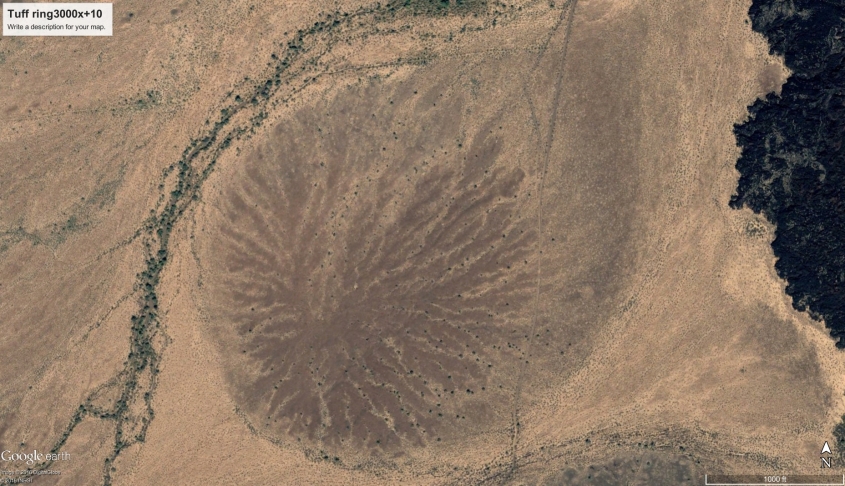


El Pinacate…

End.







 No one fully understands tornadoes. Scientists and weather nerds chase them all over the Midwest every spring; they can’t hide. So what’s the mystery?
No one fully understands tornadoes. Scientists and weather nerds chase them all over the Midwest every spring; they can’t hide. So what’s the mystery?


 If you want to make a whirlpool fast, put the spoon all the way down and stir at the bottom of the bucket. Then it forms quickly, like opening a drain. To ‘descend’, the vortex needs to be pulled down by the low pressure created by centrifugal effects of the rotating water around it. If the bulk body of water around the vortex isn’t rotating, the funnel loses coherency and dissipates.
If you want to make a whirlpool fast, put the spoon all the way down and stir at the bottom of the bucket. Then it forms quickly, like opening a drain. To ‘descend’, the vortex needs to be pulled down by the low pressure created by centrifugal effects of the rotating water around it. If the bulk body of water around the vortex isn’t rotating, the funnel loses coherency and dissipates.
 Another theory proposes that the vortex is drawn to the ground when a descending column of air and rain wraps around a funnel cloud.
Another theory proposes that the vortex is drawn to the ground when a descending column of air and rain wraps around a funnel cloud.
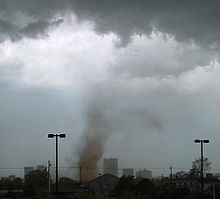 Did they see one tornado fluctuating in strength, or two vortexes in sequence? The disappearance and reappearance is so rapid it is hard to imagine the atmospheric dynamic that would cause it.
Did they see one tornado fluctuating in strength, or two vortexes in sequence? The disappearance and reappearance is so rapid it is hard to imagine the atmospheric dynamic that would cause it.
 Updraft winds don’t produce much lightning until they reach 10 to 20 mph. Then strike frequency escalates with updraft speed. From 20 to 50 mph wind speeds, lightning frequency might be 5 to 20 strikes per minute, whereas above 90 mph, the flash rate can exceed one strike per second.
Updraft winds don’t produce much lightning until they reach 10 to 20 mph. Then strike frequency escalates with updraft speed. From 20 to 50 mph wind speeds, lightning frequency might be 5 to 20 strikes per minute, whereas above 90 mph, the flash rate can exceed one strike per second.




 The geometry in a negative corona is three concentric regions of emission. The inner region, corresponding to the peak distribution of charge density, is ionizing plasma where high energy primary electron-neutral collisions avalanche. The intermediate ring is a non-ionizing plasma where electrons collide with neutral oxygen and water vapor with insufficient energy to avalanche, but produce a plasma of primarily negative ions that drift to the flat plate electrode and complete the circuit. The outer region is a flow of negative ions and sparse electrons known as the unipolar region.
The geometry in a negative corona is three concentric regions of emission. The inner region, corresponding to the peak distribution of charge density, is ionizing plasma where high energy primary electron-neutral collisions avalanche. The intermediate ring is a non-ionizing plasma where electrons collide with neutral oxygen and water vapor with insufficient energy to avalanche, but produce a plasma of primarily negative ions that drift to the flat plate electrode and complete the circuit. The outer region is a flow of negative ions and sparse electrons known as the unipolar region. The Ionizing Plasma Region…
The Ionizing Plasma Region…



 The funnel cloud doesn’t always emerge from the center of the wall cloud, as shown in most consensus science diagrams. The tornado funnel often appears along the edges of the wall cloud, or from the surrounding clouds.
The funnel cloud doesn’t always emerge from the center of the wall cloud, as shown in most consensus science diagrams. The tornado funnel often appears along the edges of the wall cloud, or from the surrounding clouds.
 Mr. Keller also reported he heard hissing sounds from the multiple vortex tendrils at the base of the funnel. Funnel clouds and small tornadoes are known to produce harmonic sounds of whistling, whining, humming, or buzzing bees, like electricity. As ozone is liberated it produces such a hissing sound.
Mr. Keller also reported he heard hissing sounds from the multiple vortex tendrils at the base of the funnel. Funnel clouds and small tornadoes are known to produce harmonic sounds of whistling, whining, humming, or buzzing bees, like electricity. As ozone is liberated it produces such a hissing sound.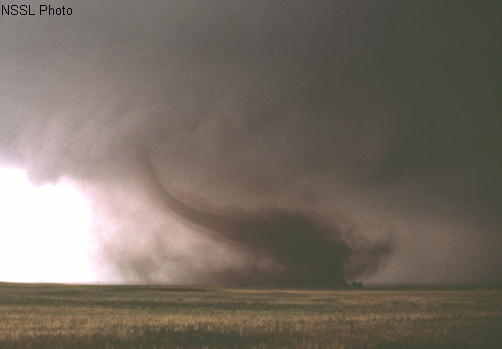
 So what if there is no super-cell? How do all the other vortex phenomena form – landspouts, waterspouts, gustnadoes and dust devils, and how are they related.
So what if there is no super-cell? How do all the other vortex phenomena form – landspouts, waterspouts, gustnadoes and dust devils, and how are they related.
